In Part 1 of the TwitterFiles, we learned that Twitter was working with politicians, federal agencies, and Biden’s campaign team to censor information on Twitter – specifically as related to Hunter Biden’s laptop and the ensuing New York Post story.
In Part 2, we learned that teams of Twitter employees build blacklists, prevent disfavored tweets from trending, and actively limit the visibility of entire accounts or even trending topics—all in secret, without informing users. In other words, “blacklisting” and “shadowbanning” were real, despite congressional testimony by people like Jack Dorsey claiming otherwise.
In Part 3, we revealed how Twitter employees and directors escalated their censorship campaign in January 2020… and how they effectively threw out the rulebook in favor of their own partisan ideals.
In Part 4, we learned how Twitter executives built the case for a permanent ban – something unprecedented for a world leader up to that point. More importantly, we learned how that “decision” was written in stone before it ever happened.
In Part 5, we uncovered the uncouth truth about what really happened at Twitter when they chose to permanently ban a sitting US president from one of the most-viewed social platforms in the world.
In Part 6, we learned just how closely Twitter worked with government agencies – particularly the FBI – to shut down posts and accounts… all behind closed doors. Twitter’s contact with the FBI was constant and pervasive, as if it were a subsidiary.
In Part 7, we discovered how the FBI & intelligence community discredited factual information about Hunter Biden’s foreign business dealings before the New York Post broke the story about Biden’s laptop… and how the FBI gave Twitter nearly $3.5 million for their cooperation.
In Part 8, we found out how Twitter quietly aided the pentagon’s covert online PsyOp campaign. Despite promises to shut down covert state-run propaganda networks, Twitter docs show that the social media giant directly assisted the U.S. military’s influence operations.
In Part 9, we’ll learn about “Other Government Agencies” (which is the federal codeword for the CIA), and how that agency was intimately involved in the effort to silence dissenting opinions on Twitter and other tech/media platforms.
After weeks of “Twitter Files” reports, the FBI issued a statement Wednesday.
It didn’t refute allegations. Instead, it decried “conspiracy theorists” publishing “misinformation,” whose “sole aim” is to “discredit the agency.”

They must think us unambitious, if our “sole aim” is to discredit the FBI. After all, a whole range of government agencies discredit themselves in the #TwitterFiles. Why stop with one?
The files show the FBI acting as doorman to a vast program of social media surveillance and censorship, encompassing agencies across the federal government – from the State Department to the Pentagon to the CIA.
The operation is far bigger than the reported 80 members of the Foreign Influence Task Force (FITF), which also facilitates requests from a wide array of smaller actors – from local cops to media to state government.
Thousands upon thousands of official “reports” flowed through the FITF and the FBI’s San Francisco field office.
On June 29th, 2020, San Francisco FBI agent Elvis Chan wrote to pair of Twitter execs asking if he could invite an “OGA” to an upcoming NGO-sponsored conference:

OGA, or “Other Government Organization,” is often a euphemism for CIA, and according to multiple former intelligence officials and contractors.
Chuckles one: “They use it to seem mysterious to outsiders.”
“Other Government Agency (the place where I worked for 27 years),” says retired CIA officer Ray McGovern.
It was an open secret at Twitter that one of its executives was ex-CIA, which is why Chan referred to that executive’s “former employer.” The first Twitter executive abandons all pretense to stealth and emails that the employee “used to work for the CIA, so that is Elvis’s question.”

Senior legal executive Stacia Cardille, who had good op-sec by Twitter standards, replies, “I know” and “I thought my silence was understood.”
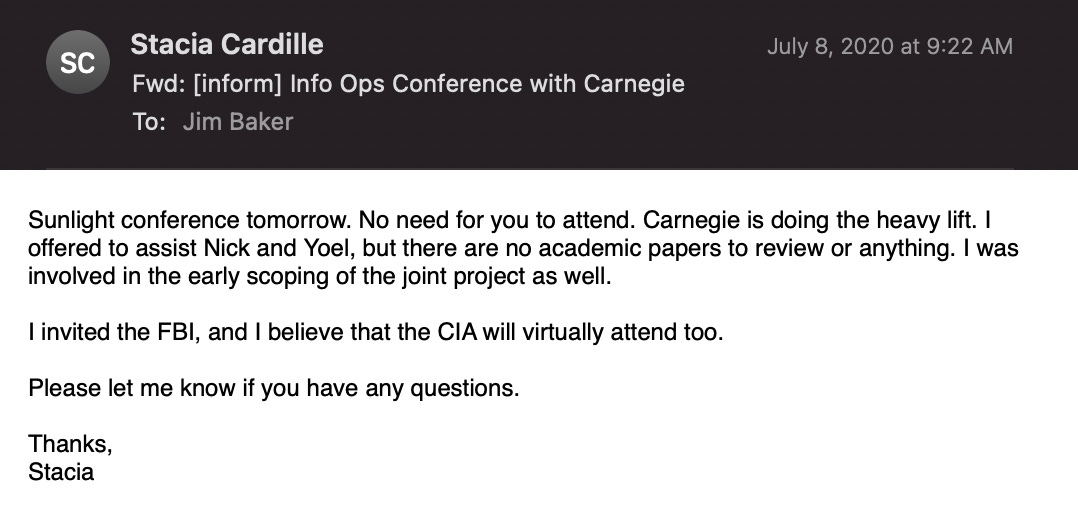
Cardille then passes on conference details to recently-hired ex-FBI lawyer Jim Baker. “I invited the FBI and the CIA virtually will attend too,” Cardille says to Baker, casually adding: “No need for you to attend.”
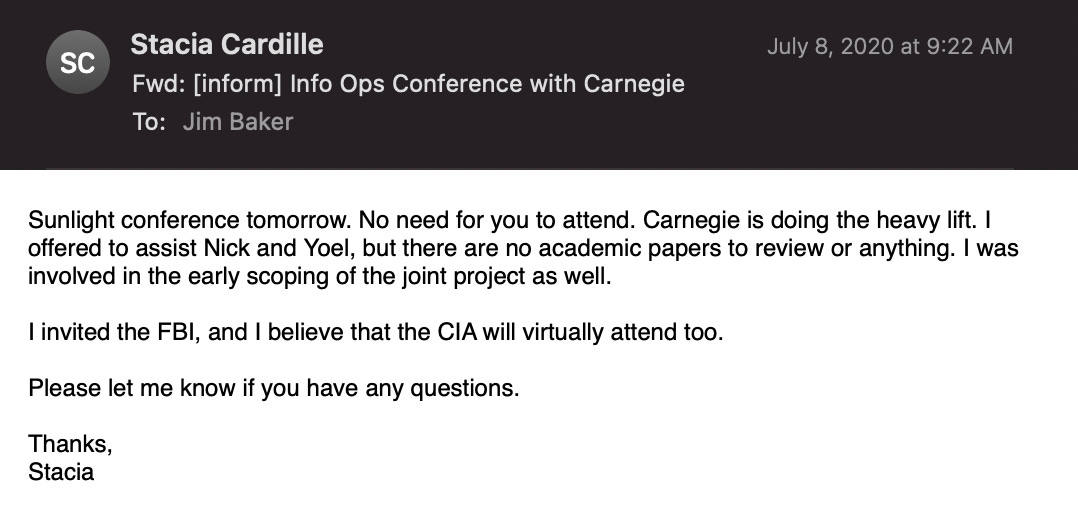
The government was in constant contact not just with Twitter but with virtually every major tech firm. These included Facebook, Microsoft, Verizon, Reddit, even Pinterest, and many others.
One of the most common forums was a regular meeting of the multi-agency Foreign Influence Task Force (FITF), attended by spates of executives, FBI personnel, and – nearly always – one or two attendees marked “OGA.”
The FITF meeting agendas virtually always included, at or near the beginning, an “OGA briefing,” usually about foreign matters (hold that thought).
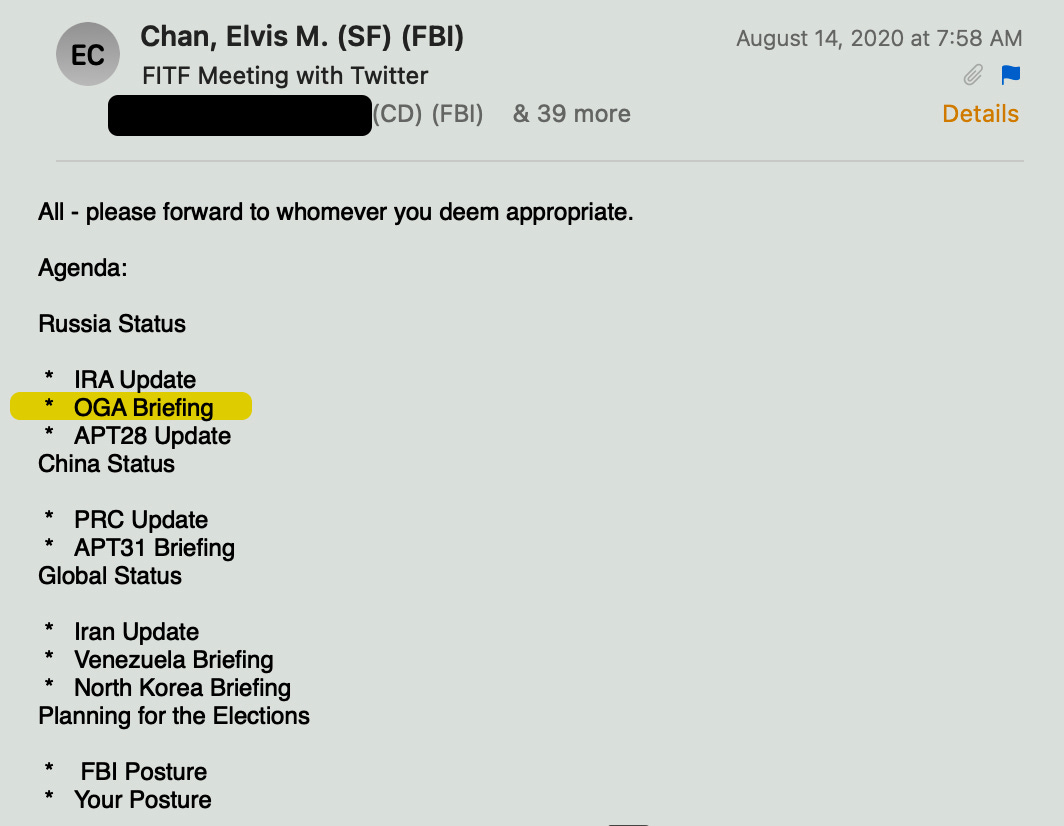
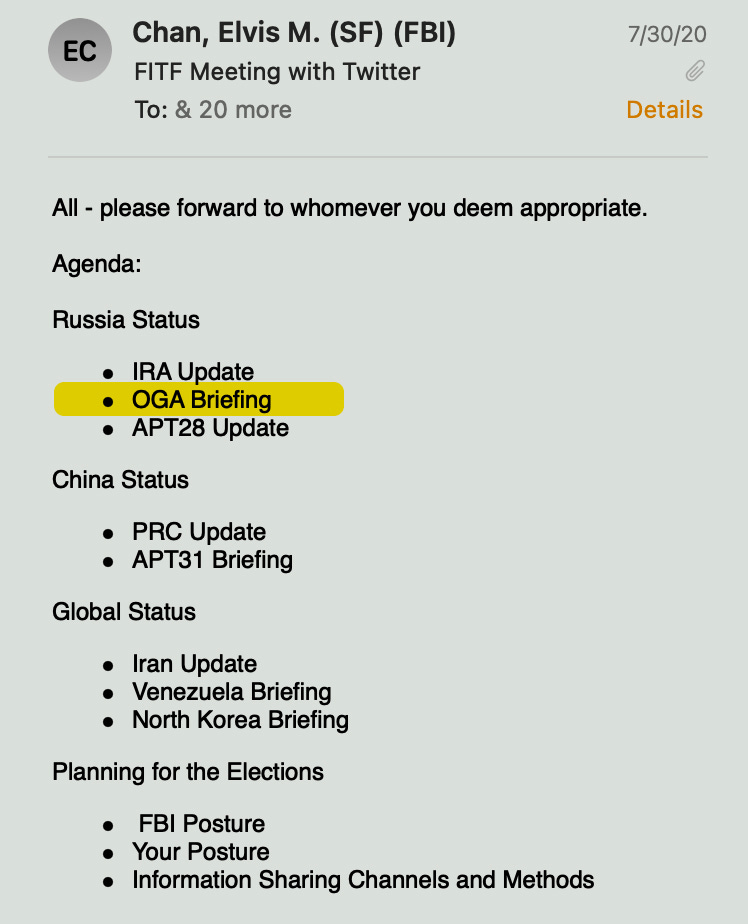

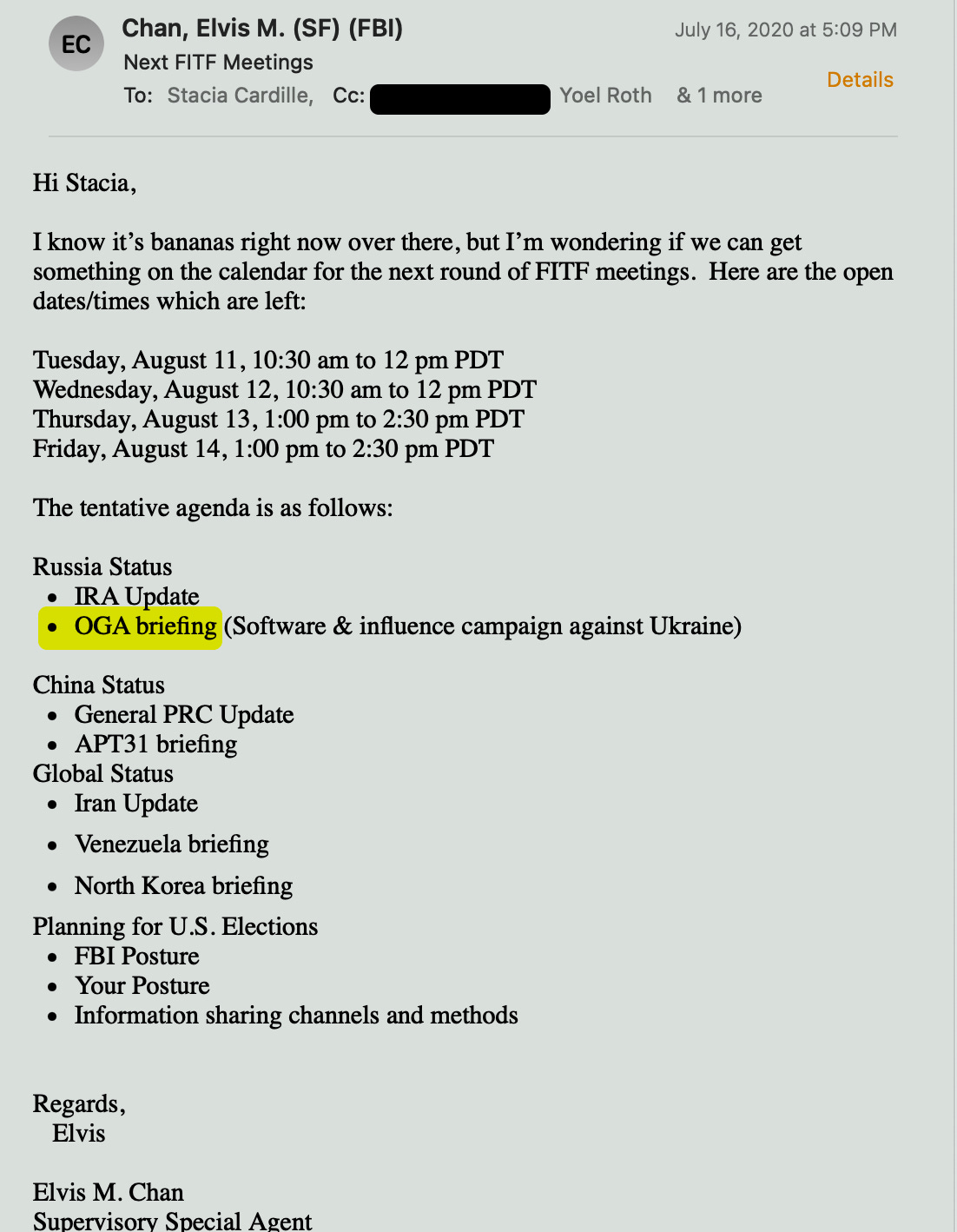
Despite its official remit being “Foreign Influence,” the FITF and the SF FBI office became conduit for mountains of domestic moderation requests, from state governments, even local police:
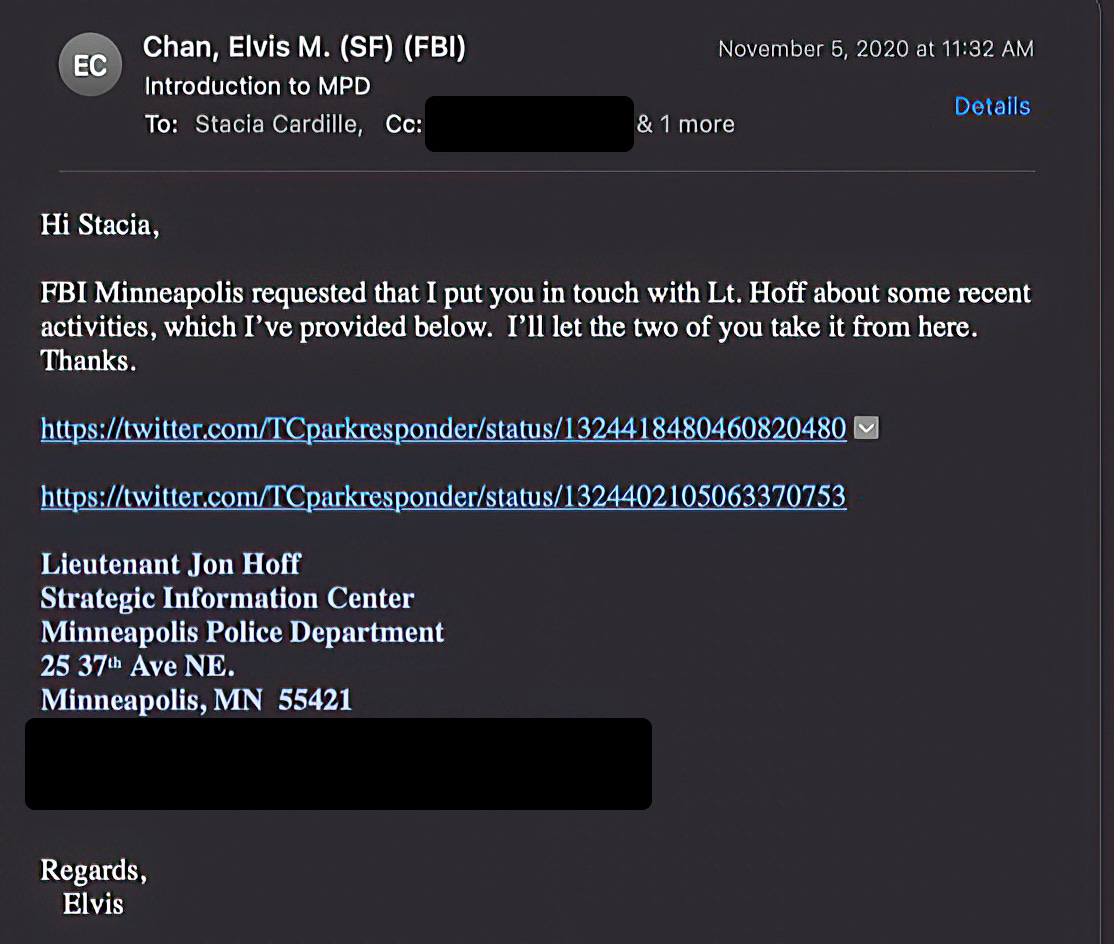
Many requests arrived via Teleporter, a one-way platform in which many communications were timed to vanish:

Especially as the election approached in 2020, the FITF/FBI overwhelmed Twitter with requests, sending spreadsheets with hundreds of accounts:
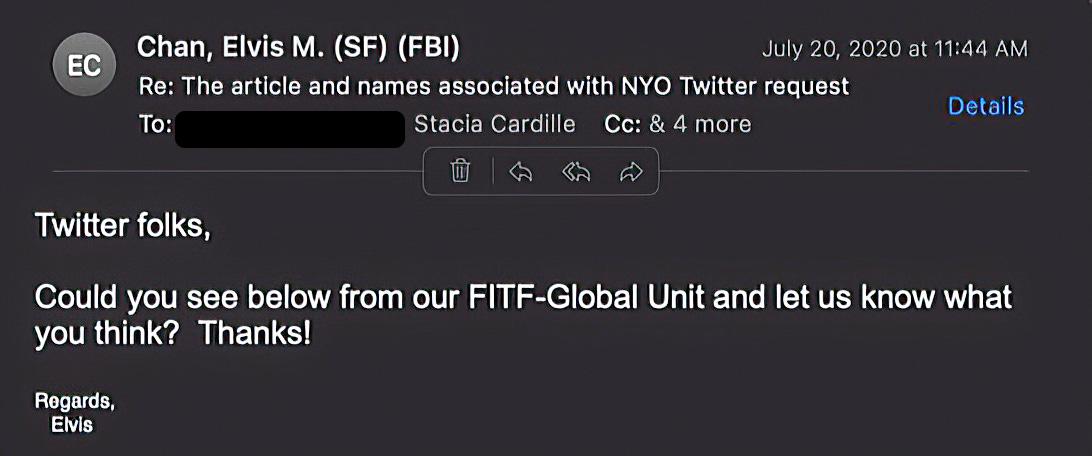

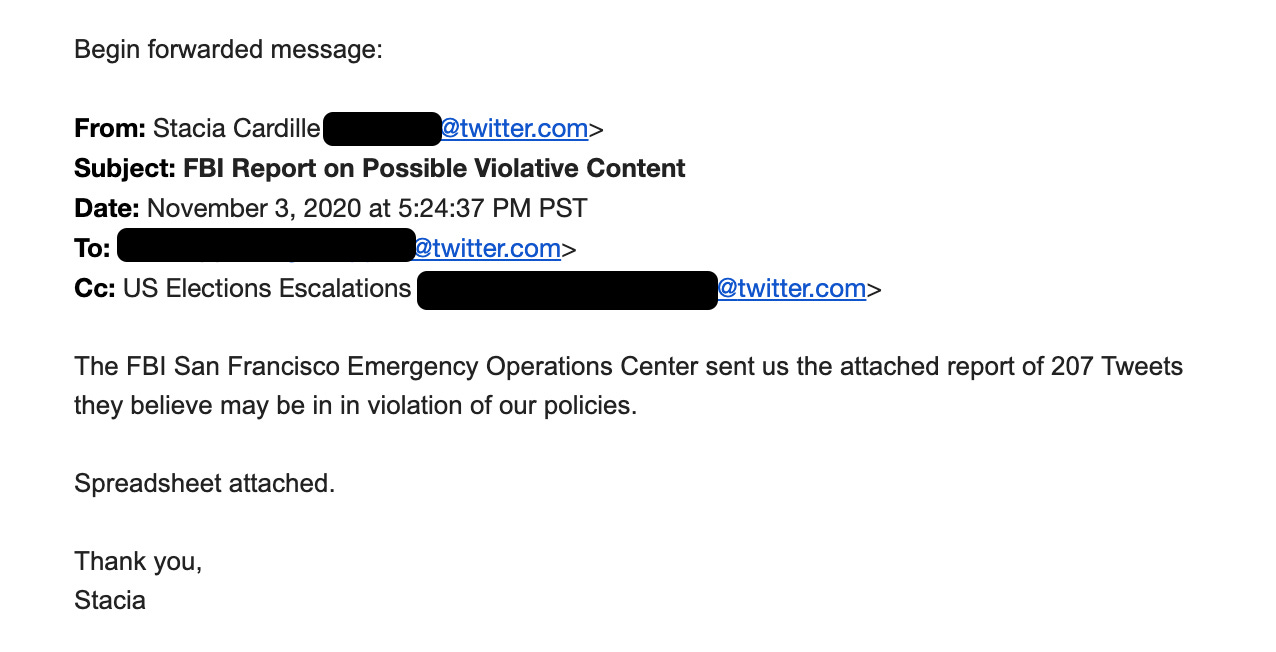
Email after email came from the San Francisco office heading into the election, often adorned with an Excel attachment:
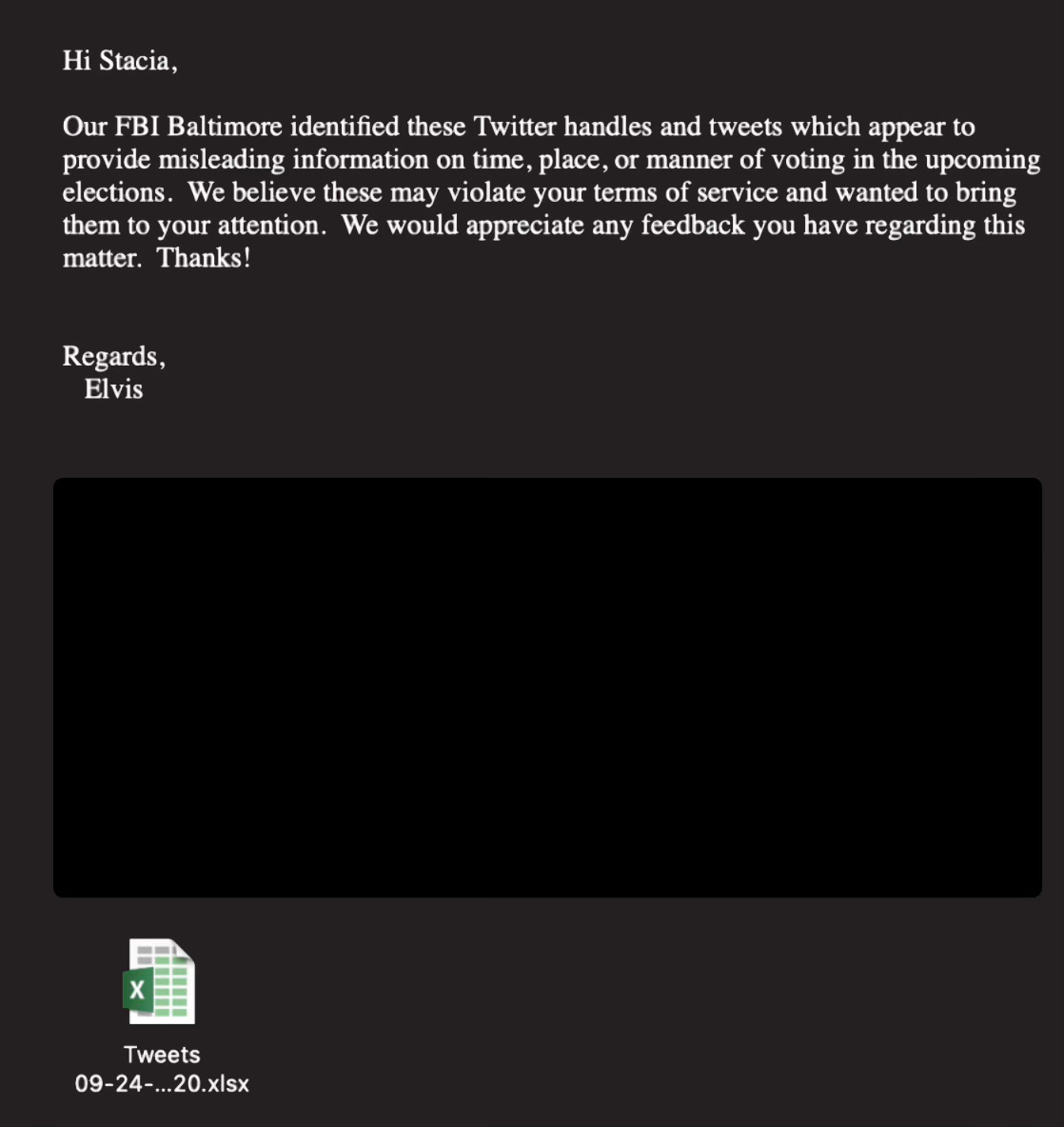
There were so many government requests, Twitter employees had to improvise a system for prioritizing/triaging them:
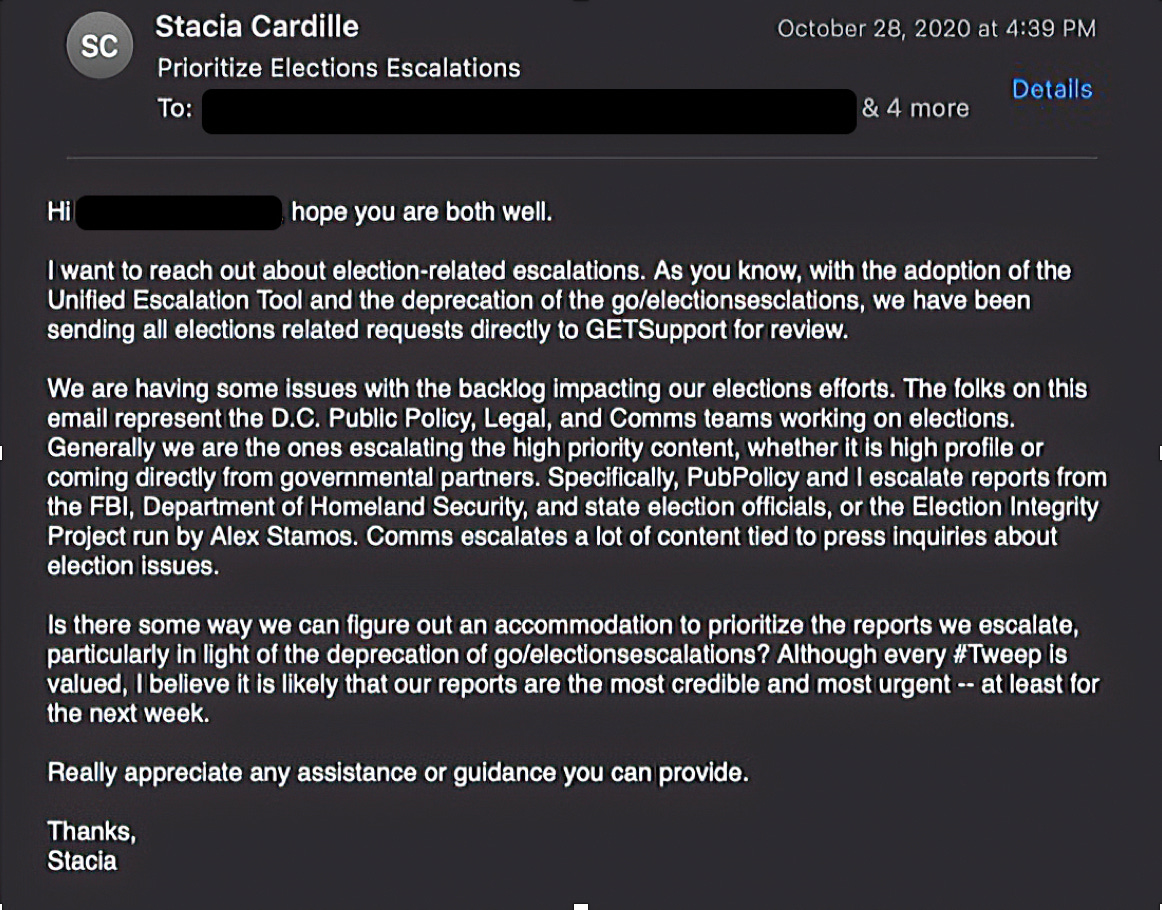
The FBI was clearly tailoring searches to Twitter’s policies. FBI requests were almost always phrased as “possible terms of service violation” somewhere, even in the subject line:

Twitter executives noticed the FBI appeared to be assigning personnel to look for Twitter violations.
“They have some folks in the Baltimore field office and at HQ that are just doing keyword searches for violations. This is probably the 10th request I have dealt with in the last 5 days,” remarked Cardille.
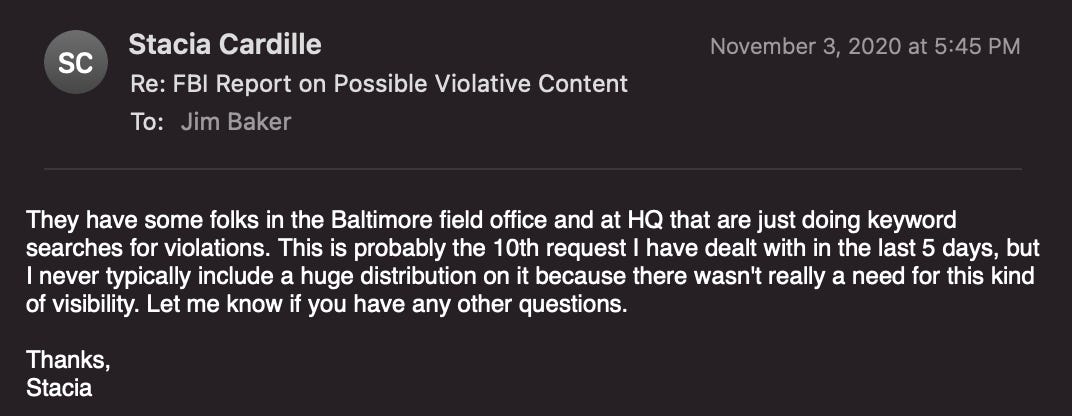
Even ex-FBI lawyer Jim Baker agreed: “Odd that they are searching for violations of our policies.”

Although so much of this activity was domestic, “Foreign meddling” had been the ostensible justification for expanded moderation since platforms like Twitter were dragged to the Hill by the Senate in 2017:

Yet behind the scenes, Twitter executives struggled against government claims of foreign interference, on their platform and others:

The #TwitterFiles show execs under constant pressure to validate theories of foreign influence – and unable to find evidence for key assertions.
“Found no links to Russia,” says one analyst, but suggests he could “brainstorm” to “find a stronger connection.”

“Extremely tenuous circumstantial chance of being related,” says another.

“No real matches using the info,” says former Trust and Safety chief Yoel Roth in another case, noting some links were “clearly Russian,” but another was a “house rental in South Carolina?”
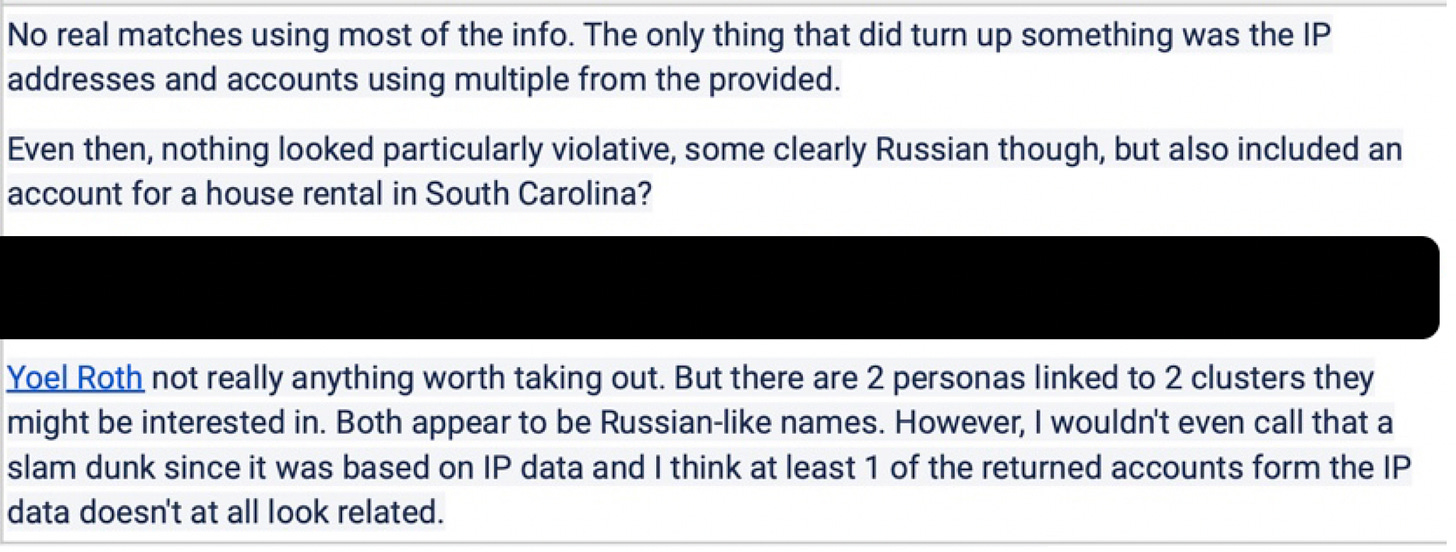
In another case, Roth concludes a series of Venezuelan pro-Maduro accounts are unrelated to Russia’s Internet Research Agency, because they’re too high-volume:
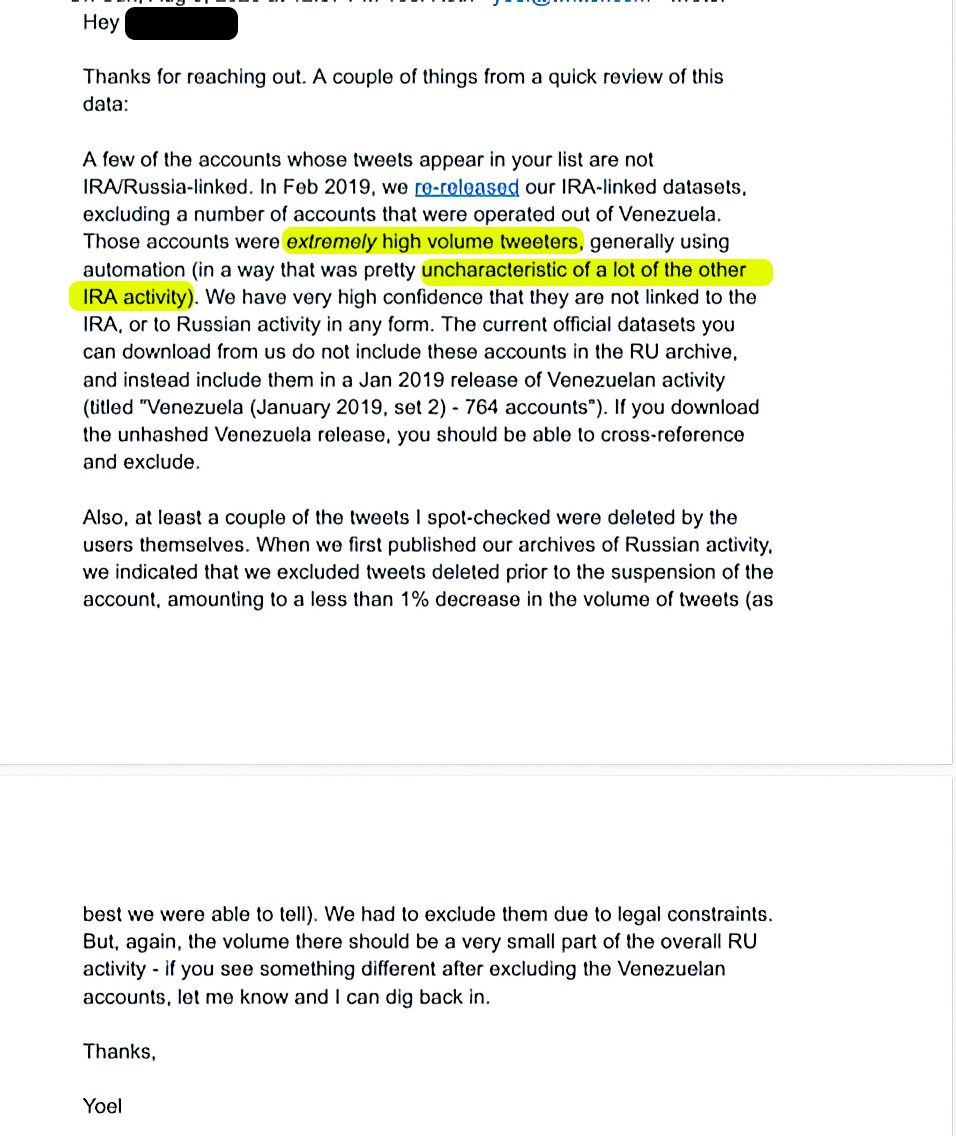
The Venezuelans “were extremely high-volume tweeters… pretty uncharacteristic of a lot of the other IRA activity,” Roth says.
In a key email, news that the State Department is making a wobbly public assertion of Russian influence leads an exec – the same one with the “OGA” past – to make a damning admission:
“Due to a lack of technical evidence on our end, I’ve generally left it be, waiting for more evidence,” he says. “Our window on that is closing, given that government partners are becoming more aggressive on attribution.”
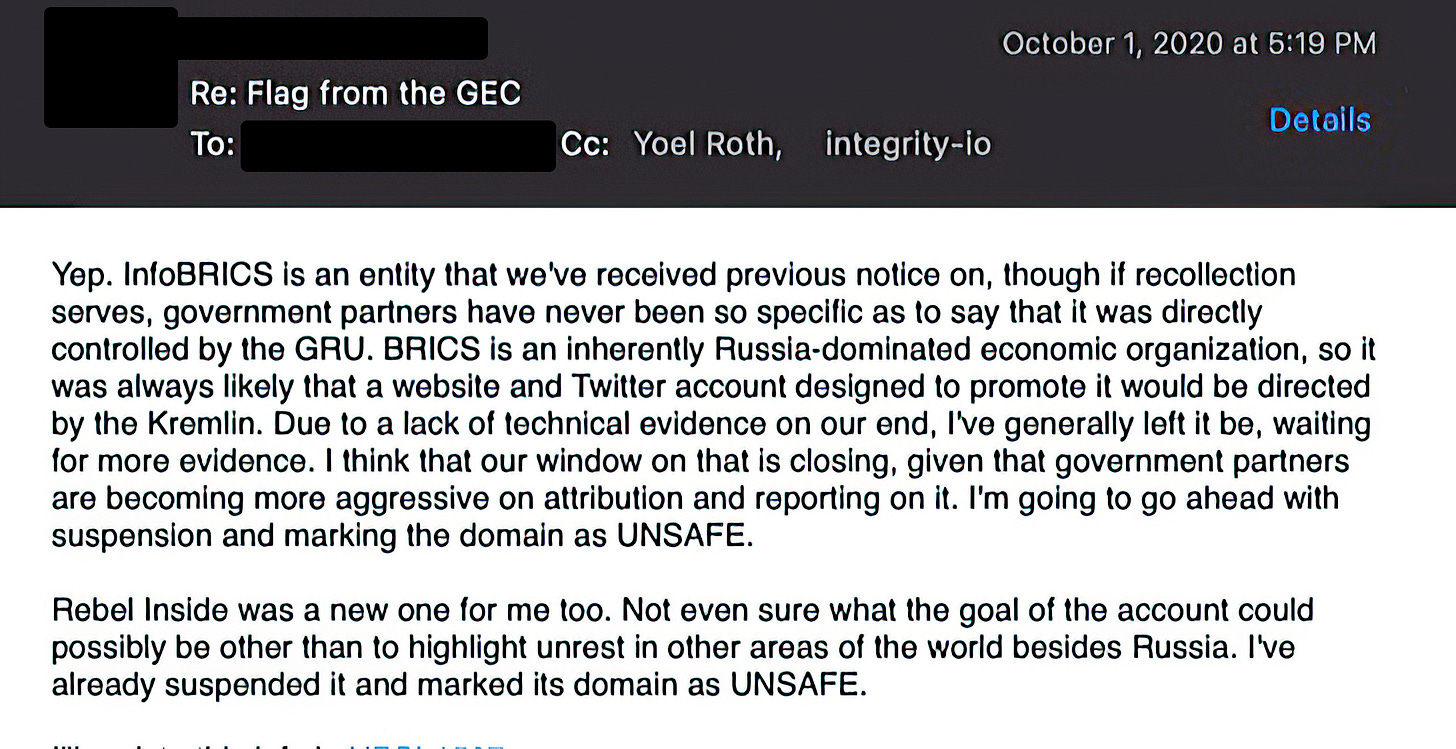
Translation: the “more aggressive” “government partners” had closed Twitter’s “window” of independence.
“Other Government Agencies” ended up sharing intelligence through the FBI and FITF not just with Twitter, but with Yahoo!, Twitch, Clouldfare, LinkedIn, even Wikimedia:

CIA whistleblower John Kiriakou believes these reports found in the #TwitterFiles are written by his former agency.
“Looks right on to me,” Kiriakou says, noting that “what was cut off above [the “tearline”] was the originating CIA office and all the copied offices.”
These reports are far more factually controversial than domestic counterparts.
One intel report lists accounts tied to “Ukraine ‘neo-Nazi’ Propaganda.’” This includes assertions that Joe Biden helped orchestrate a coup in 2014 and “put his son on the board of Burisma.”
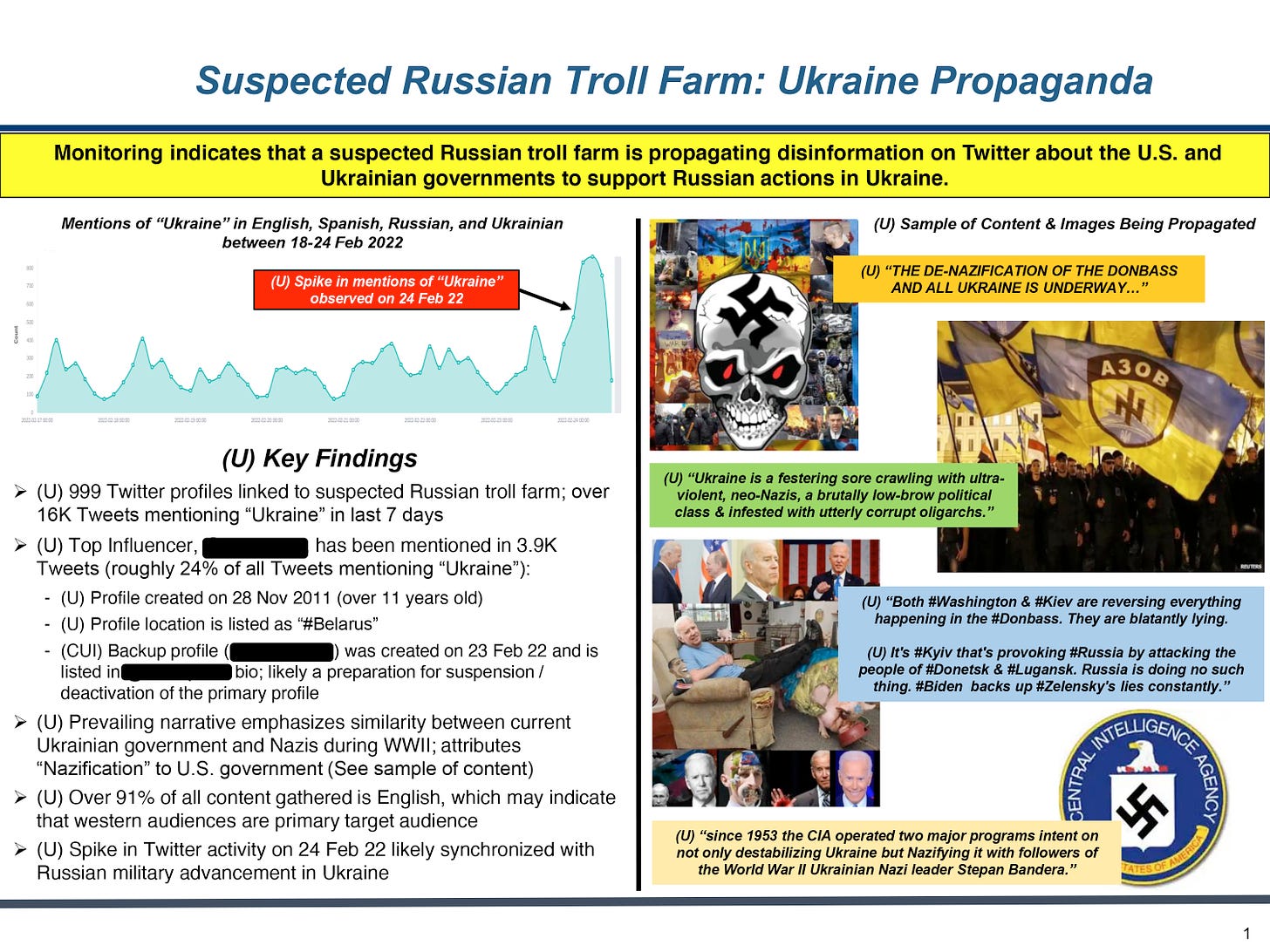
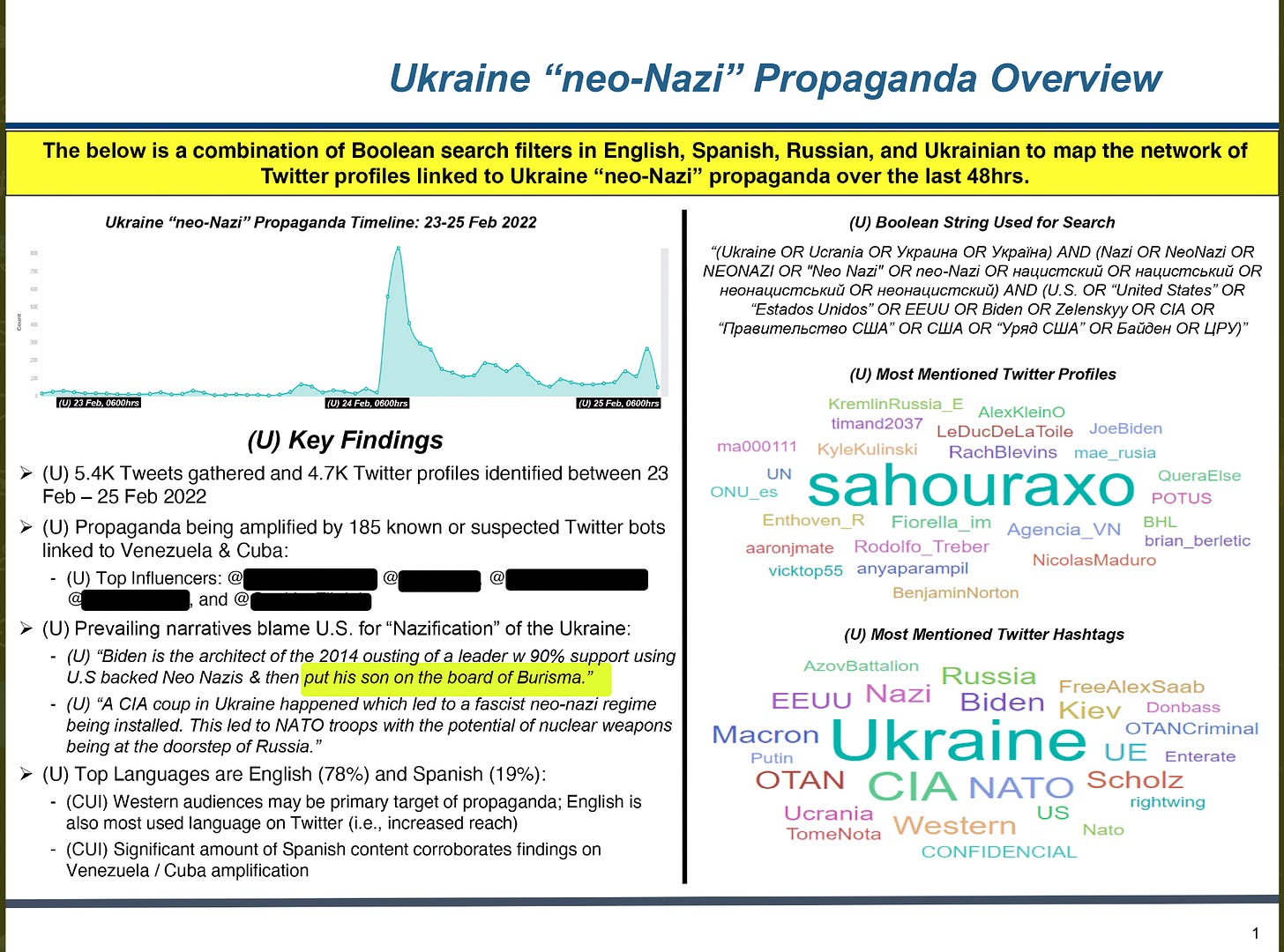
Another report asserts a list of accounts accusing the “Biden administration” of “corruption” in vaccine distribution are part of a Russian influence campaign:

Often intelligence comes in the form of brief reports, followed by long lists of accounts deemed to be pro-Maduro, pro-Cuba, pro-Russia, etc: This batch contained over 1000 accounts sentenced to the digital beyond:
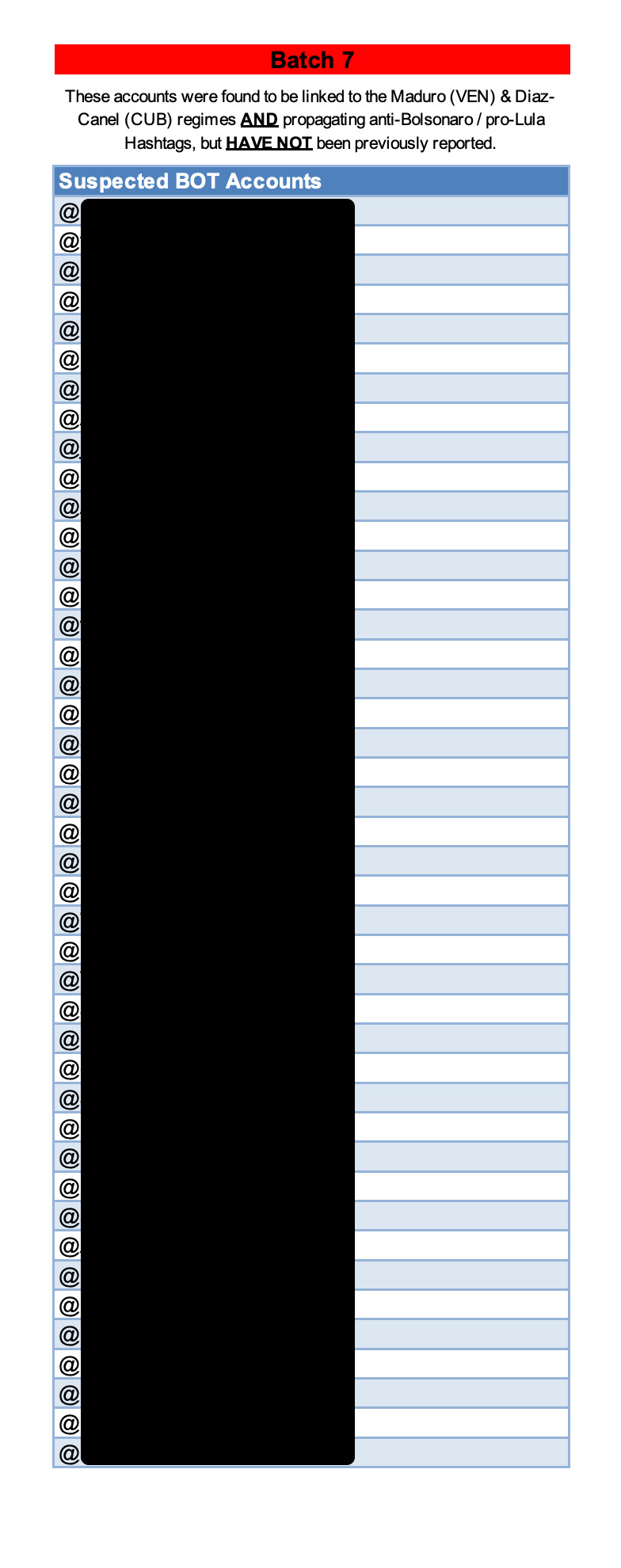
One report says a site “documenting purported rights abuses committed by Ukrainians” is directed by Russian agents:

Intel about the origin of these accounts might be true. But so might the information in them – about neo-Nazis, or rights abuses in Donbas, etc.
This is a difficult speech dilemma. Should the government be allowed to try to prevent Americans (and others) from seeing pro-Maduro or anti-Ukrainian accounts?
Often intel reports are just long lists of newspapers, tweets or YouTube videos guilty of “anti-Ukraine narratives”:
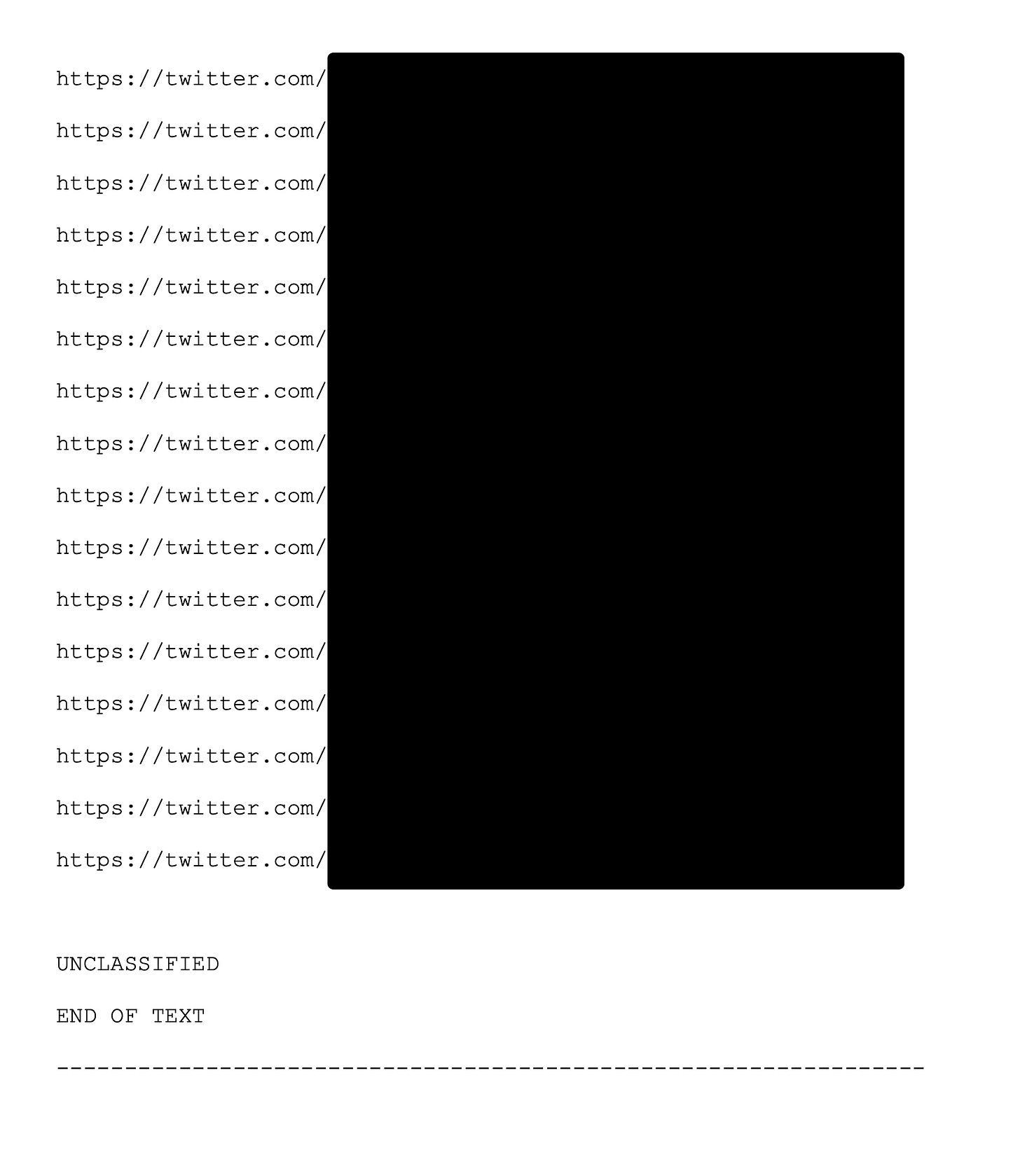
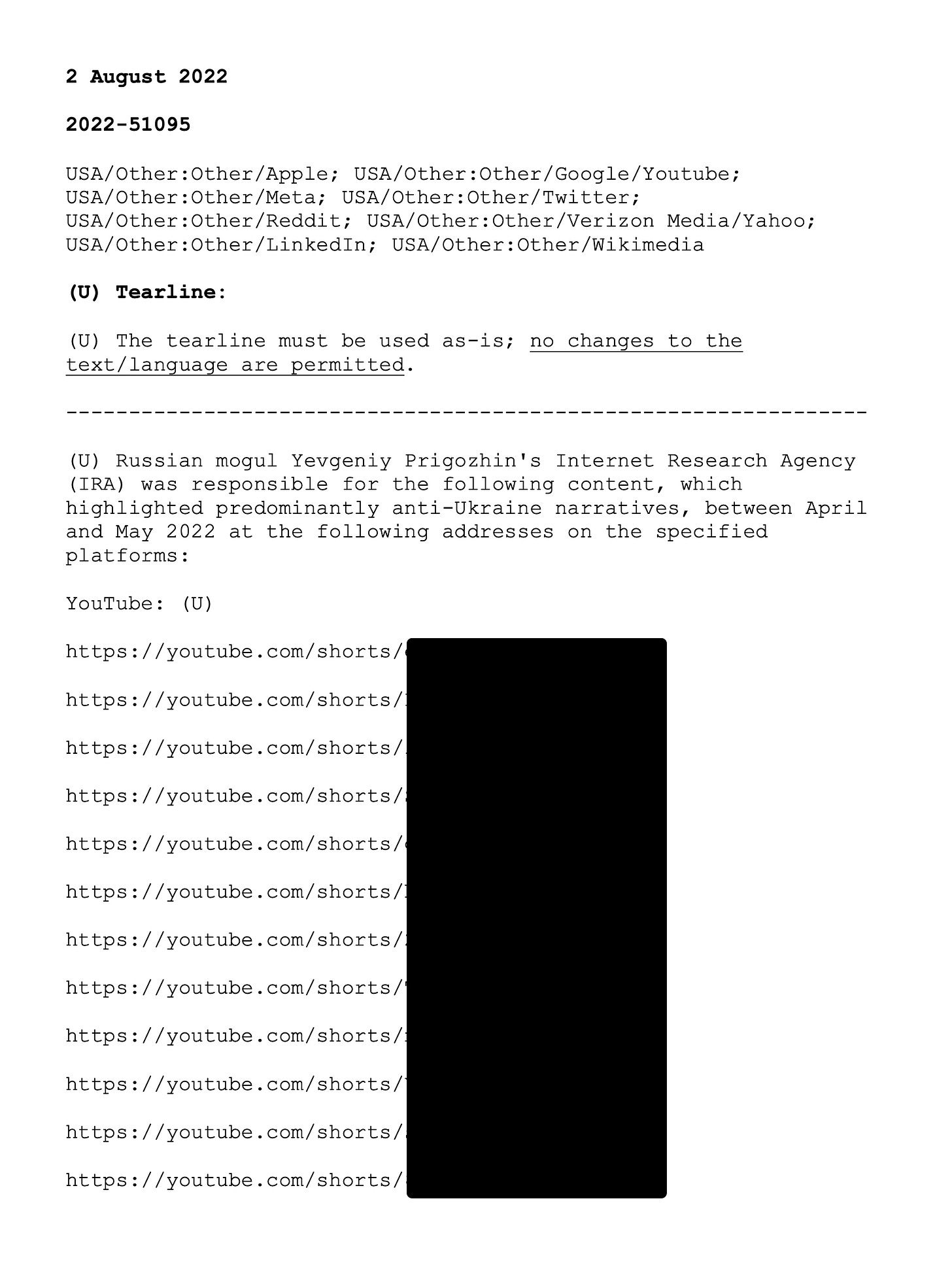
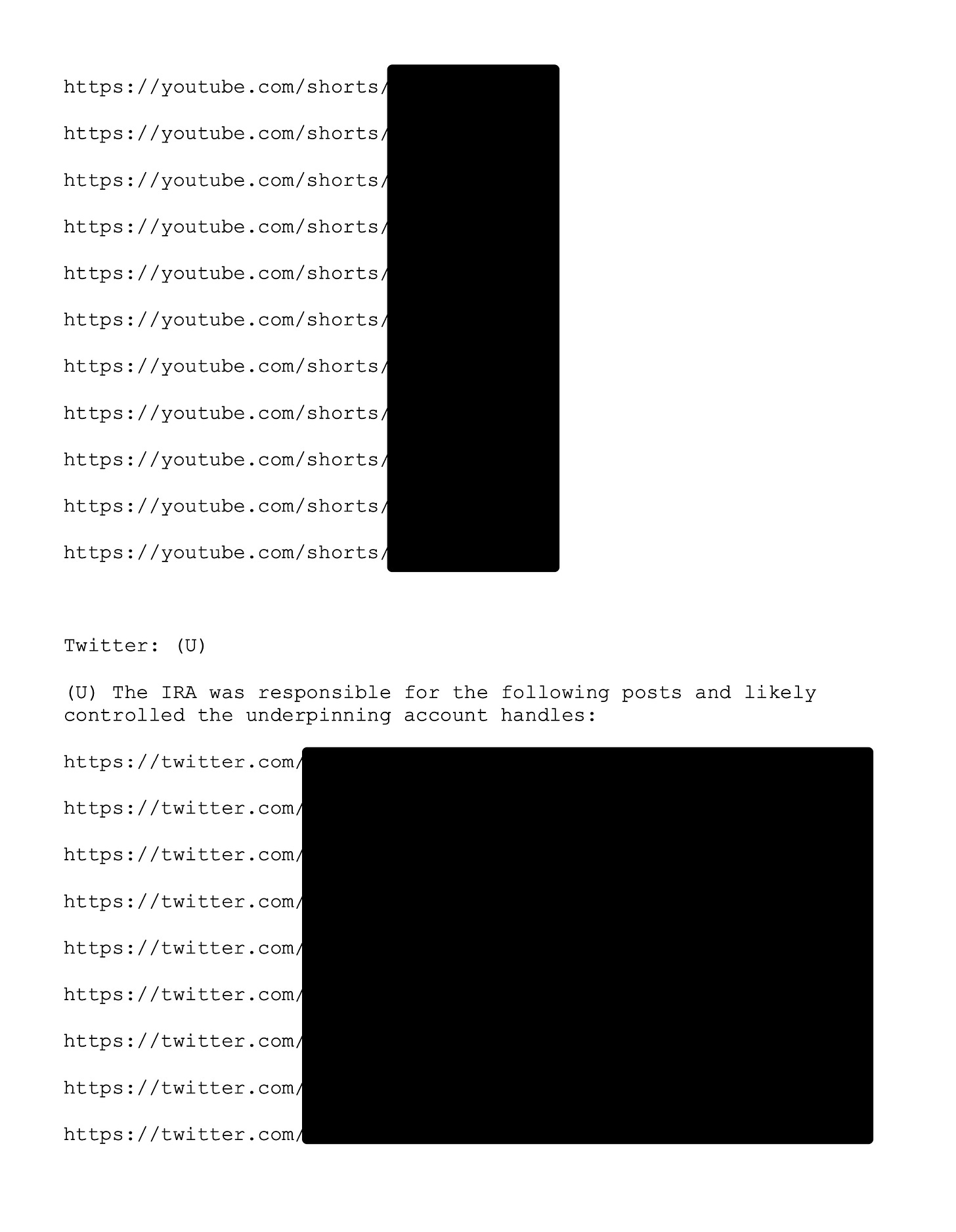
Sometimes – not always -Twitter and YouTube blocked the accounts. But now we know for sure what Roth meant by “the Bureau (and by extension the IC).”
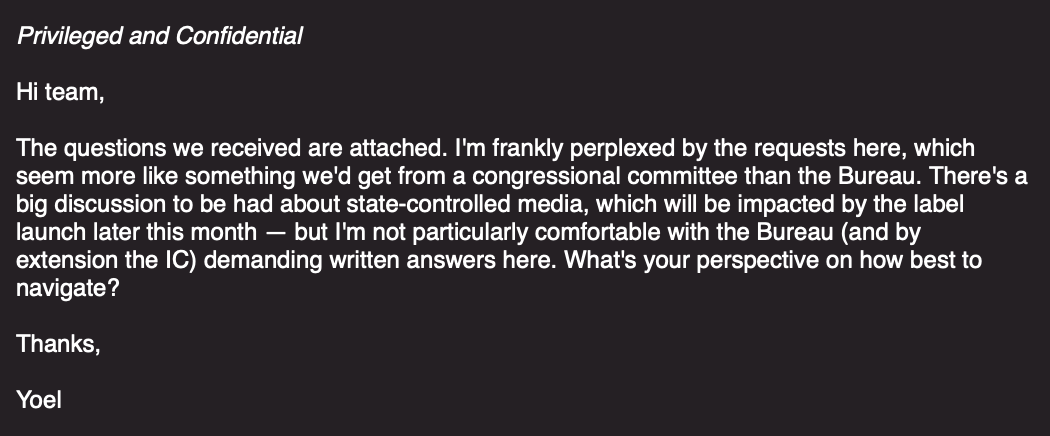
The line between “misinformation” and “distorting propaganda” is thin. Are we comfortable with so many companies receiving so many reports from a “more aggressive” government?



















Leave a Reply